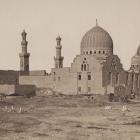J. Pascal Sebah (1838-1886), "Cairo. Tombs and Mosques of Sultan El Barkouk", circa 1870-1880, albumen print, 198x260 mm, inv. VE Albo G 3/64
J. Pascal Sebah started his career in 1857 opening the El Chark printing works (meaning “the Orient “ in Arabic) in Constantinople, together with Antoine Laroche in what was referred to as the “Avenue des Photographs” on Grande Rue de Péra 439 next to the Russian Embassy. The studio specialised in oriental costumes, a genre in great demand among European travellers of the time, as well as cityscapes, portraying the capital's monuments, architecture and landmarks. The name Sebah was present at numerous exhibitions, from the Paris Universal Exhibition of 1867 to those of the Société Française de Photographie, of which his was a member, in 1869 and 1870. In 1873 he opened another studio in Cairo and the same year received an award at the Vienna Universal Exhibition, where, now official photographer to the Sultan, he presented an album containing 42 photographs, titled Les Costumes populaires de la Turquie en 1873, dedicated to the popular “subjects” that were widespread also among other studios, such as the water carrier, the rag salesman and dervishes. The subjects of the Sebah are rendered without an excess of artifice, such as the addition of accessories or painted backdrops. His catalogue of Egyptian scenery include the tombs of the mamelukes, the pyramids, the citadel of Assuan, the temple of Abu Simbel, the valley of Kings and other areas of particular archaeological interest. For his work on this collection he received a prize at the Philadelphia Exhibition of 1876 and the Paris Exhibition of 1878.








